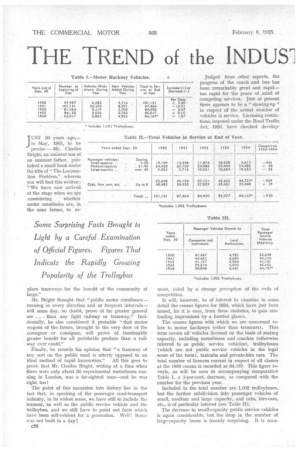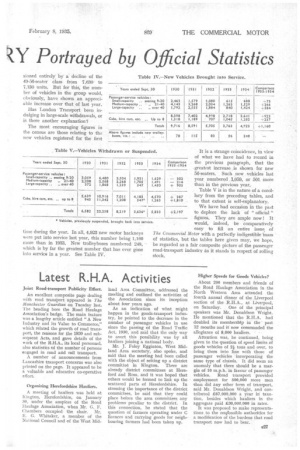THE TREND of the INDUS7
Page 88

Page 89

If you've noticed an error in this article please click here to report it so we can fix it.
ZY Portrayed by Official Statistics
place tramways for the benefit of the community at large."
Mr. Bright thought that "public motor omnibuses-running in every direction and at frequent intervalswill some day, no doubt, prove of far greater general use . . . than any light railway or tramway." Inddentally, he also considered it probable "that motor wagons of the future, brought to the very door of the consignor or consignee, will prove of inestimably greater benefit for all perishable produce than a railway ever could."
Finally, he records his opinion that "a tramway of any sort on the public road is utterly opposed to an ideal method of rapid locomotion." All this goes to prove that Mr. Charles Bright, writing at a time when there were only about 30 experimental motorbuses running in London, was a far-sighted man-and he was right, too !
The point of this excursion into history lies in the fact that, in speaking of the passenger read-transport industry, in its widest sense, we have still to include the tramcar, as well as the public service vehicle and the trolleybus, and we still have to point out facts which have been self-evident for 'a generation. Weil! Rome was not built in a day!
e26
Judged from other aspects, the progress of the coach and bus has been remarkably great and rapids:too rapid for the peace of _mind of competing services. just at present there appears to be a " slowing-up " in respect of the actual number of vehicles in service. Licensing restrictions, imposed under the Road Traffie Act, 1930, have checked develop
merit, aided by a strange perception of the evils of competition.
It will, however, be of interest to examine in some detail the census figures for 1934, which have just been issued, for it is easy, from these statistics, to gain misleading impressions by a hurried glance.
The census figures with which we are concerned relate to motor hackneys (other than tramcars). This term covers all 'vehicles licensed on the basis of seating capacity, including motorbuses and coaches (otherwise referred to as public service vehicles), trolleybusea (which are not public service vehicles in the legal sense of the term), taxicabs and private-hire cars. The total number of licences current in respect of all classes at the 1934 census is recorded as 84,167. This figure reveals, as will be seen in accompanying comparative Table I, a 1-per-cent, decrease, as compared with the number for the previous year.
Included in the total number are 1,002 trolleybuses, but the further subdivision into passenger vehicles of small, medium and large capacity, and cabs, hire-cars, etc., is of particular interest (see Table II).
The decrease in small-capacity public service vehicles is again considerable, but the drop in the number of• large-capacity buses is frankly surprising. It is occa
sioned entirely by a decline of the 49-56-seater class from 7,630 to 7,130 units. But for this; the number of vehicles in the group would, obviously, have shown an appreciable increase over that of last year.
Has London Transport been indulging in large-scale withdrawals, or is there another explanation?
The most encouraging figures in the census are those relating to the new vehicles registered for the first time during the year. In all, 4,923 new motor hackneys were put into service last year, this number being 1,160 more than in 1933. New trolleybuses numbered 248, which is by far the greatest number that has ever gone into service in a year. See Table IV. It is a strange coincidence, in view of what we have had to record in the previous paragraph, that the greatest increase is shown for new 56-seaters. Such new vehicles last year numbered 1,059, or 501 more than in the previous year.
Table V is in the nature of a corollary from the preceding tables, and to that extent is self-explanatory.
We have had occasion in the past to deplore the lack of " official " figures. They are ample now It would, indeed, be comparatively easy to fill an entire issue of
The Gommercia2 Motor with a perfectly indigestible Mass of statistics, but the tables here given may, we hope, be regarded as a fair composite picture of the passenger road-transport industry as it stands in respect of rolling stock.














































































































































































